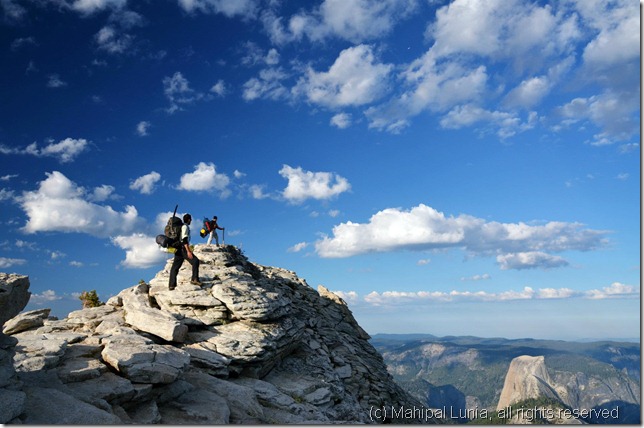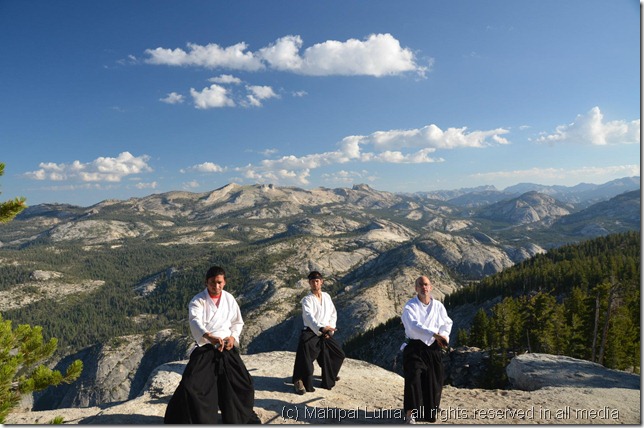Lost
Stand still. The trees ahead
and bushes beside you
Are not lost. Wherever you are is called Here.
And you must treat it as a powerful stranger.
Must ask permission to know it and be known.
The forest breathes. Listen. It answers.
I have made this place around you.
If you leave it you may come back again.
saying Here.
No two trees are the same to Raven.
No two branches are the same to Wren.
If what a tree or a bush does is lost on you.
You art surely lost. Stand still.
The forest knows
Where you are. You must let it find you.
- An Old Native Indian Poem, translated by David Wagoner
After an exhausting day-long climb, we reached the top of Cloudsrest and marveled at the beauty of the Sierras while looking down on the iconic Half Dome. It was time for yet another shugyo deep in the backcountry of California’s famed Yosemite National Park. We put our 40 plus pound bags down, wiped the sweat of our brows, and found new energy from the beauty that surrounded and engulfed us. We experienced sheer silence, sheer presence, and a complete sense of belonging as we relaxed into our beings.
One of my students said, “This is so worth it—this view makes up for all of it. I am almost ready to cry.” I told him to let go and let the tears roll, and forget yourself and fuse completely with nature all around. Later, as the sun set on the horizon and the temperatures dropped drastically, it struck me that “Nature and Self are both Path and Destination” and how much this has defined my own philosophy and how I teach my expression of the arts I have learnt from my teachers.
There exist no conflicts or opposing principles in nature—the distinction of good and bad is a man-made context. And all conflict arises within this separation. There is no inherent conflict in nature itself. Later, cuddled up in my sleeping bag under the beautiful night sky, I remembered the reruns of Kung Fu with David Carradine that I had watched incessantly all through my childhood, waiting for my Master Kan. I was lucky to have not one, but a few. In one of the first episodes of Kung Fu, there is an iconic scene where Master Kan tells the young grasshopper, “In the Shaolin temple, there are three kinds of men: students, disciples, and masters. Development of the mind can be achieved only when the body has been disciplined. To accomplish this, the ancients have taught us to imitate God’s creatures. From the crane, we learn grace and self-control. The snake teaches us suppleness and rhythmic endurance. The praying mantis teaches us speed and patience. And from the tiger, we learn tenacity and power. And from the dragon, we learn to ride the wind. All creatures—the low and the high—are one with nature. If we have the wisdom to learn, all may teach us their virtues. Between the fragile beauty of the praying mantis and the fire and passion of the winged dragon, there is no discord. Between the supple silence of the snake and the eagle’s claws, there is only harmony. As no two elements of nature are in conflict, when we perceive the ways of nature, we remove conflict within ourselves and discover a harmony of body and mind in accord with the flow of the universe. It may take half a lifetime to master one system.” I fell asleep with a smile, thinking how wonderfully the threads of life weave themselves.
At the crack of dawn, I woke the three apprentices, as it was time to soak in the sun and train some more. Soaking in the beauty of the first rays of sun at 11,000 ft., I noticed my sense of Self had expanded far beyond my physical body and was zooming through space to merge with the rays of the sun itself. Frank Herbert, in his Dune Series, had brilliantly said, “Self is infinitely flexible, expanding to include desirable and useful others, and contracting to exclude the undesirable and harmful. Individually and collectively, how we fashion this entity determines the structure of the world we live in and the nature of the problems we must solve.” At this moment, it made perfect sense. And in those moments where everything is void, and therefore also possible, no limitations or problems appear. The samurai have long called this Mushin or ‘no-mind’ (which is a terrible term, but must suffice for now). This is the state of clarity every samurai warrior longed for in the battlefield and on the tatami mats. And yet, it is here, ready to be experienced. What is needed is a method to dial into it. More on a few techniques to dial into this state in future posts.
We worked on the Katana (Japanese Blade/dagger) forms, and had the three apprentices take a portion of their test on the granite rocks of Sierras. Two hours in, we wrapped up and were ready to now begin the long descent down the mountain back to our cars parked deep down in Yosemite. One apprentice spoke up and said “This is so wonderful, but now its time to go back. I am sad.” I smiled, and explained to him that this beauty and sense of expansiveness is present everywhere—it’s not the domain of just the peaks/highs of life. This is how life is meant to be. It’s not just the destination/arrival that matters, but also how we arrive and depart from there.” He looked at me, half confused, but intently started walking down. After a few hours of silent walking interspersed by some discussions on Jesus, Osho, Bruce Lee, and our love lives, I bought the conversation back to the topic of path and destination.
“Nature and Self are both path and destination. Meaning, we use Nature and the body proper as the gateway to enter, traverse, and find that state of mushin/annyata/total fusion (martial arts/bhuddism/Tantra), which is ever present in Nature and the body proper. By learning to tune the body, in our case using the martial arts of Kaze, we are able to dial into that state where the I & Thou disappear—and something else entirely different emerges. It’s that something different that does the fighting when need be. It’s that something different that teaches when you are ready. And it’s that something different that dissolves all tensions and brings about a sense of complete calm.” I had my students complete, rapt attention as I continued, also somewhat surprised at my discovery and the words coming out of my mouth. David Whyte had once mentioned in a seminar, “Poetry is the art of saying things you did not know you knew.” I had experienced not only words, but entire forms of fighting emerge from that place in my body proper, much as my Senseis had told me years ago would happen.
I continued, “The body is the temple of the soul. Now, do you know what the word temple means? It comes from the word template—therefore, the really good question to ask is what is the body a template of?” Seeing the confused looks, which I always love (as they are usually the beginning of something new ready to come in and take seat), I just continued walking away. This has taken years of practice to do, but always yields good results. I wanted to leave them with the question, rather than a dogma or my truth.
A few days later, back in the dojo, the student walked up and said, “I felt peace in the mountains, and I want to go back there.” I told him there is no ‘there,’ and he needs to learn to have it here, as the body is the template of the universe itself, and in caring for the body proper and using it as both the path and destination, we arrive at that state of not leaving, wanting, or striving—and yet feeling fulfilled. It’s a hard task. I don’t claim to be able to do it all the time, and I train myself to take my body there every possible time—and hence, I show up at the dojo so often. Dojo—place of the way. Again, the place of the way to where? To the Self. As Herman Hesse so eloquently penned “every man is a path to himself.”
I closed the nested loop for my students, as I always do after a few weeks with this talk of “Nature and Self are both path and destination.” This is a foundational principle of how I specifically work with people at Mt. View Aiki Kai. This is my expression, my truth, and myself carving out my way. I want to close this piece with the words of the eminent mythologist Joseph Campbell, “ The goal of life is to make your heartbeat match the beat of the universe, to match your nature with Nature.” And our way of doing this is with the martial arts of Kaze, and using both Nature and Self as path and destination. If you do not understand this, you probably won’t follow much of what follows. You will remain a student, and never quite become a disciple/apprentice, leave alone attain mastery. The way to understand this is not an intellectual endeavor, but rather a deeply felt sense of path and destination becoming one, of Nature and Self fusing. And yet, as Master Kan had said in Kung Fu, “It may take years to understand.”
- stream of consciousness writing to explain the guiding philosophy of Mt. View Aiki Kai by Mahipal Lunia Sensei. These are his own personal views and do not represent the art/s, system/s, or teacher/s he has studied with.


